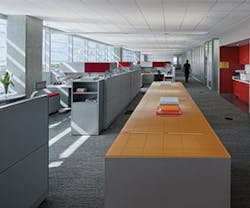Cooling Critical Operations at Chandler City Hall
Founded in 1891, Chandler, AZ, is a city of 240,100 in Maricopa County, a major suburb of Phoenix.
“Seeing the inevitable need for office consolidation, for more than 20 years we have been setting aside funds to pay for a new municipal complex,” says Marian Norris, Chandler’s assistant city manager. “We wanted a mixed-use facility to cater to the community’s needs and serve as an icon of excellent design and sustainability.”
Tapped to design and engineer a five-story tower that would be central to a new municipal campus was the Phoenix office of SmithGroupJJR (Smith). The resulting 137,000-square-foot civic center campus encompasses a multitude of different offices, including council chambers, a television studio and a community art gallery. In May 2013, Chandler became one of only 24 city halls in the U.S. to receive LEED Gold certification.
Jon Silhol, PE, was Smith’s lead mechanical engineer on the project. For the city hall’s vital nerve centers – 17 electrical rooms and nine data closets located throughout the campus – he needed a high-performance HVAC system that could handle the constant heat gain produced by the electrical equipment while also meeting the city’s energy reduction goals. It was imperative for Silhol to specify a mission-critical system to keep the temperature in these rooms at a constant 75 degrees F. These systems simply could not fail. Silhol quickly selected a Variable Refrigerant Flow (VRF) zoning system from Mitsubishi Electric Heating & Cooling.
“I had seen this VRF technology work successfully in other projects locally. The Y-Series technology is the industry’s most reliable system for mission-critical data centers,” Silhol explains. “And the diversity of Mitsubishi’s systems provided me with other excellent options for the public spaces in Chandler’s buildings, including the TV studio, print shop, elevator stairwells, bathrooms and hallways.”
For these spaces, Silhol selected the R2-Series – the industry’s only two-pipe heat recovery system that simultaneously cools and heats multiple zones.
The Mitsubishi system provides another big advantage in case of emergency. With the VRF zoning system separate from the HVAC systems conditioning the rest of the campus, in the event of a catastrophic power failure, the stand-by generators will power the Y-Series and one of the R2-Series systems. This enables continued cooling of the nerve centers without having to provide HVAC for the rest of the complex.
The electrical load requirement of the Y-Series is low compared to other HVAC systems, making it even easier for a generator to power.
“Selection of the Mitsubishi Electric system was the right choice for our nerve centers,” says Kris Kircher, facilities maintenance manager for the City of Chandler. “In addition to the energy savings we have witnessed, I have been delighted with the trouble-free performance of the Mitsubishi Electric systems. I especially like the design and diversity of the equipment, which gives me the flexibility to place the proper fan coil into the right space with either ducted or wall-mounted units.”
See why Mitsubishi Electric is right for your project at MitsubishiPro.com/Ready.
